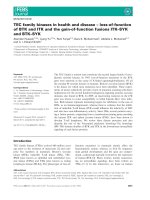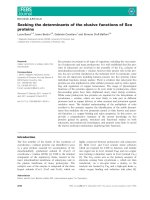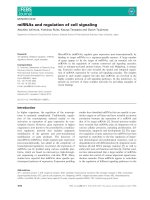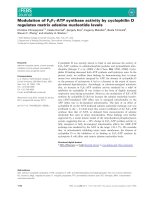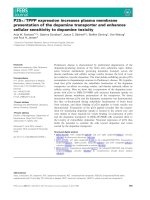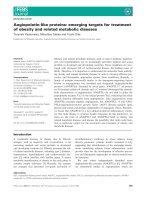Báo cáo khoa học: "LAZY UNIFICATION" pptx
Bạn đang xem bản rút gọn của tài liệu. Xem và tải ngay bản đầy đủ của tài liệu tại đây (320.9 KB, 8 trang )
LAZY UNIFICATION
Kurt Godden
Computer Science Department
General Motors Research Laboratories
Warren, MI 48090-9055, USA
CSNet:
ABSTRACT
Unification-based NL parsers that copy
argument graphs to prevent their destruction
suffer from inefficiency. Copying is the
most expensive operation in such parsers,
and several methods to reduce copying have
been devised with varying degrees of
success. Lazy Unification is presented here
as a new, conceptually elegant solution that
reduces copying by nearly an order of
magnitude. Lazy Unification requires no new
slots in the structure of nodes, and only
nominal revisions to the unification
algorithm.
PROBLEM STATEMENT
degradation in performance. This
performance drain is illustrated in Figure 1,
where average parsing statistics are given for
the original implementation of graph
unification in the TASLINK natural language
system. TASLINK was built upon the LINK
parser in a joint project between GM Research
and the University of Michigan. LINK is a
descendent of the MOPTRANS system
developed by Lytinen (1986). The statistics
below are for ten sentences parsed by
TASLINK. As can be seen, copying consumes
more computation time than unification.
20.0
19 91%
Unification is widely used in natural
language processing (NLP) as the primary
operation during parsing. The data
structures unified are directed acyelic
graphs (DAG's), used to encode grammar
rules, lexical entries and intermediate
parsing structures. A crucial point
concerning unification is that the resulting
DAG is constructed directly from the raw
material of its input DAG's, i.e. unification
is a destructive operation. This is especially
important when the input DAG's are rules of
the grammar or lexical items. If nothing
were done to prevent their destruction
during unification, then the grammar would
no longer have a correct rule, nor the lexicon
a valid lexical entry for the DAG's in
question. They would have been transformed
into the unified DAG as a side effect.
The simplest way to avoid destroying
grammar rules and lexical entries by
unification is to copy each argument DAG
prior to calling the unification routine. This
is sufficient to avoid the problem of
destruction, but the copying itself then
becomes problematic, causing severe
b/.17Vo
I-
Unification •
Copying []
Other
j
Figure 1. Relative Cost of
Operations during Parsing
PAST SOLUTIONS
Improving the efficiency of unification
has been an active area of research in
unification-based NLP, where the focus has
been on reducing the amount of DAG copying,
and several approaches have arisen.
Different versions of structure sharing were
employed by Pereira (1985) as well as
Karttunen and Kay (1985). In Karttunen
(1986) structure sharing was abandoned for
a technique allowing reversible unification.
Wroblewski (1987) presents what he calls a
non-destructive unification algorithm that
avoids destruction by incrementally copying
the DAG nodes as necessary.
180
All of these approaches to the copying
problem suffer from difficulties of their
own. For both Pereira and Wroblewski there
are special cases involving convergent arcs
ares from two or more nodes that point to the
same destination node that still require full
copying. In Karttunen and Kay's version of
structure sharing, all DAG's are represented
as
binary
branching DAG's, even though
grammar rules are more naturally
represented as non-binary structures.
Reversible unification requires two passes
over the input DAG's, one to unify them and
another to copy the result. Furthermore, in
both successful and unsuccesful unification
the input DAG's must be restored to their
original forms because reversible unification
allows them to be destructively modified.
Wroblewski points out a useful
distinction between
early
copying and
over
copying. Early copying refers to the copying
of input DAG's before unification is applied.
This can lead to inefficiency when
unification fails because only the copying
up
to
the point of failure is necessary. Over
copying refers to the fact that when the two
input DAG's are copied they are copied in
their entirety. Since the resultant unified
DAG generally has fewer total nodes than the
two input DAG's, more nodes than necessary
were copied to produce the result.
Wroblewski's algorithm eliminates early
copying entirely, but as noted above it can
partially over copy on DAG's involving
convergent arcs. Reversible unification may
also over copy, as will be shown below.
LAZY UNIFICATION
I now present
Lazy Unification
(LU)
as a new approach to the copying problem. In
the following section I will present statistics
which indicate that LU accomplishes
nearly
an order of magnitude reduction
in copying
compared to non-lazy, or
eager unification
(EU). These results are attained by turning
DAG's into active data structures to
implement the lazy evaluation of copying.
Lazy evaluation is an optimization
technique developed for the interpretation of
functional programming languages (Field and
181
Harrison, 1988), and has been extended to
theorem proving and logic programming in
attempts to integrate that paradigm with
functional programming (Reddy, 1986).
The concept underlying lazy evaluation
is simple: delay the operation being
optimized until the value it produces is
needed by the calling program, at which
point the delayed operation is forced. These
actions may be implemented by high-level
procedures called
delay and force.
Delay is
used in place of the original call to the
procedure being optimized, and force is
inserted into the program at each location
where the results of the delayed procedure
are needed.
Lazy evaluation is a good technique for
the copying problem in graph unification
precisely because the overwhelming majority
of copying is unnecessary. If all copying can
be delayed until a destructive change is
about to occur to a DAO, then both early
copying and over copying can be completely
eliminated.
The delay operation is easily
implemented by using
closures.
A closure is
a compound object that is both procedure and
data. In the context of LU, the data portion
of a closure is a DAG node. The procedural
code within a closure is a function that
processes a variety of messages sent to the
closure. One may generally think of the
encapsulated procedure as being a suspended
call to the copy function. Let us refer to
these closures as
active nodes
as contrasted
with a
simple node
not combined with a
procedure in a closure. The delay function
returns an active node when given a simple
node as its argument. For now let us assume
that delay behaves as the identity function
when applied to an active node. That is, it
returns an active node unchanged. As a
mnemonic we will refer to the delay function
as
delay-copy-the-dag.
We now redefine DAG's to allow either
simple
or
active nodes wherever simple
nodes were previously allowed in a DAG. An
active node will be notated in subsequent
diagrams by enclosing the node in angle
brackets.
In LU the unification algorithm proceeds
largely as it did before, except that at every
point in the algorithm where a destructive
change is about to be made to an active node,
that node is first replaced by a copy of its
encapsulated node. This replacement is
mediated through the force function, which
we shall call force-delayed-copy. In the case
of a simple node argument force-delayed-
copy acts as the identity function, but when
given an active node it invokes the suspended
copy procedure with the encapsulated node
as argument. Force-delayed-copy returns
the DAG that results from this invocation.
To avoid copying an entire DAG when
only its root node is going to be modified by
unification, the copying function is also
rewritten. The new version of copy-the-dag
takes an optional argument to control how
much of the DAG is to be copied. The default
is to copy the entire argument, as one would
expect of a function called copy-the-dag.
But when copy-the-dag is called from inside
an active node (by force-delayed-copy
invoking the procedural portion of the active
node), then the optional argument is
supplied with a flag that causes copy-the-
dag to copy only the root node of its
argument. The nodes at the ends of the
outgoing arcs from the new root become
active nodes, created by delaying the
original nodes in those positions. No
traversal of the DAG takes place and the
deeper nodes are only present implicitly
through the active nodes of the resulting
DAG. This is illustrated in Figure 2.
v _~gJ
becomes
<b>
a2<><c>
"~<d>
Figure 2. Copy-the-dag on 'a' from
Inside an Active Node
Here, DAG a was initially encapsulated
in a closure as an active node. When a is
about to undergo a destructive change by
being unified with some other DAG, force-
delayed-copy activates the suspended call to
copy-the-dag with DAG a as its first
argument and the message delay-ares as its
optional argument. Copy-the-dag then copies
only node a, returning a2 with outgoing arcs
pointing at active nodes that encapsulate the
original destination nodes b, e, and d. DAG
a2 may then be unified with another DAG
without destroying DAG a, and the
unification algorithm proceeds with the
active nodes <b>, <c>, and <d>. As these
subdag's are modified, their nodes are
likewise copied incrementally. Figure 3
illustrates this by showing DAG a2 after
unifying <b>. It may be seen that as active
nodes are copied one by one, the resulting
unified DA(3 is eventually constructed.
b2
a2~i<c>
"~<d>
Figure 3. DAG a2 after Unifying <b>
One can see how this scheme reduces the
amount of copying if, for example,
unification fails at the active node <e>. In
this case only nodes a and b will have been
copied and none of the nodes e, d, e, f, g, or
h. Copying is also reduced when unification
succeeds, this reduction being achieved in
two ways.
182
First, lazy unification only creates new
nodes for the DAG that results from
unification. Generally this DAG has fewer
total nodes than the two input
DAG's.
For
example, if the 8-node DAG a in Figure 2
were unified with the 2-node DAG a >i, then
the resulting DAG would have only nine
nodes, not ten. The result DAG would have
the arc ' >i' copied onto the 8-node DAG's
root. Thus, while EU would copy all ten
original nodes, only nine are necessary for
the result.
Active nodes that remain in a final DAG
represent the other savings for successful
unification. Whereas EU copies all ten
original nodes to create the 9-node result,
LU would only create five new nodes during
unification, resulting in the DAG of Figure 4.
Note that the "missing" nodes e, f, g, and h
are implicit in the active nodes and did not
require copying. For larger DAG's, this kind
of savings in node copying can be significant
as several large sub-DAG's may survive
uncopied in the final DAG .
<b>
a2 ~ <c>
Figure 4. Saving Four Node Copies
with Active Nodes
A useful comparison with Karttunen's
reversible unification may now be made.
Recall that when reversible unification is
successful the resulting DAG is copied and
the originals restored. Notice that this
copying of the entire resulting DAG may
overcopy
some of the sub-DAG's. This is
evident because we have just seen in LU that
some of the sub-DAG's of a resulting DAG
remain uncopied inside active nodes. Thus,
LU offers less real copying than reversible
unification.
Let us look again at DAG a in Figure 2
and discuss a potential problem with lazy
unification as described thus far. Let us
suppose that through unification a has been
partially copied resulting in the DAG shown
in Figure 5, with active node <f> about to be
copied.
b2 02
a2 ~< f >~ h2
d>
Figure 5. DAG 'a' Partially Copied
Recall from Figure 2 that node f points at
e. Following the procedure described above,
<f> would be copied to f2 which would then
point at active node <e>, which could lead to
another
node e 3 as shown in Figure 6. What
is needed is some form of
memory
to
recognize that e was already copied once and
that f2 needs to point at e2 not <e>.
b2 e2
b
c<
a2 ~ ~t 2 ~~ h2
d>
Figure 6. Erroneous Splitting of Node
e into e2 and e3
This memory is implemented with a
copy
environment,
which is an association list
relating original nodes to their copies.
Before f2 is given an arc pointing at <e>, this
alist is searched to see if e has already been
copied. Since it has, e2 is returned as the
destination node for the outgoing arc from
f2, thus preserving the topography of the
original DAG.
183
Because there are several DAG's that
must be preserved during the course of
parsing, the copy environment cannot be
global but must be associated with each DAG
for which it records the copying history.
This is accomplished by encapsulating a
particular DAG's copy environment in each
of the active nodes of that DAG. Looking
again at Figure 2, the active nodes for DAG
a2 are all created in the scope of a variable
bound to an initially empty association list
for a2's copy environment. Thus, the
closures that implement the active nodes
<b>, <c>, and <d> all have access to the
same
copy environment. When <b> invokes the
suspended call to
copy-the-dag,
this
function adds the pair (b. b2)to the copy
environment as a side effect before returning
its value b2. When this occurs, <c> and <d>
instantly have access to the new pair through
their shared access to the same copy
environment. Furthermore, when new active
nodes are created as traversal of the DAG
continues during unification, they are also
created in the scope of the same copy
environment. Thus, this alist is pushed
forward
deeper into the nodes of the parent
DAG as part of the data portion of each active
node.
Returning to Figure 5, the pair (e. e2)
was added to the copy environment being
maintained for DAG a 2 when e was copied to
e2. Active node <f> was created in the scope
of this list and therefore "remembers" at the
time f2 is created that it should point to the
previously created e2 and not to a new active
node <e>.
There is one more mechanism needed to
correctly implement copy environments. We
have already seen how some active nodes
remain after unification. As intermediate
DAG's are reused during the
nondeterministic parsing and are unified
with other DAG's, it can happen that some of
these remaining active nodes become
descendents of a root different from their
original root node. As those new root DAG's
are incrementally copied during unification,
a situation can arise whereby an active
node's parent node is copied and then an
184
attempt is made to create an active node out
of an active node.
For example, let us suppose that the DAG
shown in Figure 5 is a sub-DAG of some
larger DAG. Let us refer to the root of that
larger DAG as node n. As unification of n
proceeds, we may reach a2 and start
incrementally copying it. This could
eventually result in c2 being copied to c3 at
which point the system will attempt to create
an outgoing arc for c3 pointing at a newly
created active node over the already active
node <f>. There is no need to try to create
such a beast as <<f>>. Rather, what is needed
is to assure that active node <f> be given
access to the
new
copy environment for n
passed down to <f> from its predecessor
nodes. This is accomplished by
destructively merging
the new copy
environment with that previously created for
a2 and surviving inside <f>. It is important
that this merge be destructive in order to
give all active nodes that are descendents of
n access to the same information so that the
problem of node splitting illustrated in
Figure 6 continues to be avoided.
It was mentioned previously how calls to
force-delayed-copy
must be inserted into the
unification algorithm to invoke the
incremental copying of nodes. Another
modification to the algorithm is also
necessary as a result of this incremental
copying. Since active nodes are
replaced
by
new nodes in the middle of unification, the
algorithm must undergo a revision to effect
this replacement. For example, in Figure 5
in order for <b> to be replaced by b2, the
corresponding arc from a2 must be replaced.
Thus as the unification algorithm traverses a
DAG, it also collects such replacements in
order to reconstruct the outgoing arcs of a
parent DAG.
In addition to the message
delay-arcs
sent to an active node to invoke the
suspended call to copy-the-dag, other
messages are needed. In order to compare
active nodes and merge their copy
environments, the active nodes must process
messages that cause the active node to return
either its encapsulated node's label or the
encapsulated copy environment.
40000
EFFECTIVENESS OF LAZY
UNIFICATION
Lazy Unification results in an impressive
reduction to the amount of copying during
parsing. This in turn reduces the overall
slice of parse time consumed by copying as
can be seen by contrasting Figure 7 with
Figure 1. Keep in mind that these charts
illustrate proportional computations, not
speed. The pie shown below should be
viewed as a smaller pie, representing faster
parse times, than that in Figure 1. Speed is
discussed below.
45.78%
18.67%
J l~
Unification
•
Copying
[] Other I "
Figure 7. Relative Cost of Operations
with Lazy Unification
Lazy Unification copies less than 7% of
the nodes copied under eager unification.
However, this is not a fair comparison with
EU because LU substitutes the creation of
active nodes for some of the copying. To get a
truer comparison of Lazy vs. Eager
Unification, we must add together the
number of copied nodes and active nodes
created in LU. Even when active nodes are
taken into account, the results are highly
favorable toward LU because again less than
7% of the nodes copied under EU are
accounted for by active nodes in LU.
Combining the active nodes with copies, LU
still accounts for an 87% reduction over
eager unification. Figure 8 graphically
illustrates this difference for ten sentences.
30000
Number
of 20000
Nodes
10000
Eager Lazy Active
Copies Copies Nodes
Figure 8. Comparison of Eager vs.
Lazy Unification
From the time slice of eager copying
shown in Figure 1, we can see that if LU were
to incur no overhead then an 87% reduction
of copying would result in a faster parse of
roughly 59%. The actual speedup is about
50%, indicating that the overhead of
implementing LU is 9%. However, the 50%
speedup does not consider the effects of
garbage collection or paging since they are
system dependent. These effects will be
more pronounced in EU than LU because in
the former paradigm more data structures
are created and referenced. In practice,
therefore, LU performs at better than twice
the speed of EU.
There are several sources of overhead in
LU, The major cost is incurred in
distinguishing between active and simple
nodes. In our Common Lisp implementation
simple DAG nodes are defined as named
structures and active nodes as closures.
Hence, they are distinguished by the Lisp
predicates DAG-P and FUNCTIONP.
Disassembly on a Symbolics machine shows
both predicates to be rather costly. (The
functions TYPE-OF and TYPEP could also
be used, but they are also expensive.)
185
Another expensive operation occurs when
the copy environments in active nodes are
searched. Currently, these environments are
simple association lists which require
sequential searching. As was discussed
above, the copy environments must
sometimes be merged. The merge function
presently uses the UNION function. While a
far less expensive destructive concatenation
of copy environments could be employed, the
union operation was chosen initially as a
simple way to avoid creation of circular lists
during merging.
All of these sources of overhead can and
will be attacked by additional work. Nodes
can be defined as a tagged data structure,
allowing an inexpensive tag test to
distinguish between active and inactive
nodes. A non-sequential data structure
could allow faster than linear searching of
copy environments and more efficient
merging. These and additional modifications
are expected to eliminate most of the
overhead incurred by the current
implementation of LU. In any case, Lazy
Unification was developed to reduce the
amount of copying during unification and we
have seen its dramatic success in achieving
that goal.
CONCLUDING
REMARKS
There is another optimization possible
regarding certain leaf nodes of a DAG.
Depending on the application using graph
unification, a subset of the leaf nodes will
never be unified with other DAG's. In the
TASLINK application these are nodes
representing such features as third person
singular. This observation can be exploited
under both lazy and eager unification to
reduce both copying and active node
creation. See Godden (1989) for details.
It has been my experience that using
lazy evaluation as an optimization technique
for graph unification, while elegant in the
end result, is slow in development time due
to the difficulties it presents for debugging.
This property is intrinsic to lazy evaluation,
(O'Donnell and Hall, 1988).
186
The problem is that a DAG is no
longer copied locally because the copy
operation is suspended in the active nodes.
When a DAG
is
eventually copied, that
copying is performed incrementally and
therefore non-locally in both time and
program space. In spite of this distributed
nature of the optimized process, the
programmer continues to conceptualize the
operation as occurring locally as it would
occur in the non-optimized eager mode. As a
result of this mismatch between the
programmer's visualization of the operation
and its actual execution, bugs are
notoriously difficult to trace. The
development time for a program employing
lazy evaluation is, therefore, much longer
than would be expected. Hence, this
technique should only be employed when the
possible efficiency gains are expected to be
large, as they are in the case of graph
unification. O'Donnell and Hall present an
excellent discussion of these and other
problems and offer insight into how tools
may be built to alleviate some of them.
REFERENCES
Field, Anthony J. and Peter G. Harrison.
1988.
Functional Programming.
Reading,
MA: Addison-Wesley.
Godden, Kurt. 1989. "Improving the
Efficiency of Graph Unification." Internal
technical report GMR-6928. General Motors
Research Laboratories. Warren, MI.
Karttunen, Lauri. 1986.
D-PATR: A
Development Environment for Unification-
Based Grammars.
Report No. CSLI-86-61.
Stanford, CA.
Karttunen, Lauri and Martin Kay. 1985.
"Structure-Sharing with Binary Trees."
Proceedings of the 23 rd Annual Meeting of
the Association for Computational
Linguistics.
Chicago, IL: ACL. pp. 133-
136A.
Lytinen, Steven L. 1986. "Dynamically
Combining Syntax and Semantics in Natural
Language Processing."
Proceedings of the
5 t h National Conference on Artificial
Intelligence. Philadelphia, PA- AAAI. pp.
574-578.
O'Donnell, John T. and Cordelia V. Hall.
1988. "Debugging in Applicative
Languages." Lisp and Symbolic Computation,
1/2. pp. 113-145.
Pereira, Fernando C. N. 1985. "A
Structure-Sharing Representation for
Unification-Based Grammar Formalisms."
Proceedings of the 23 rd Annual Meeting of
the Association for Computational
Linguistics. Chicago, IL: ACL. pp. 137-144.
Reddy, Uday S. 1986. "On the
Relationship between Logic and Functional
Languages," in Doug DeGroot and Gary
Lindstrom, eds. Logic Programming :
Functions, Relations, and Equations.
Englewood Cliffs, NJ. Prentice-Hall. pp. 3-
36.
Wroblewski, David A. 1987.
"Nondestructive Graph Unification."
Proceedings of the 6 th National Conference
on Artificial Intelligence. Seattle, WA:
AAAI. pp. 582-587.
187
